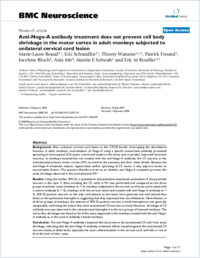Anti-Nogo-A antibody treatment does not prevent cell body shrinkage in the motor cortex in adult monkeys subjected to unilateral cervical cord lesion
- Beaud, Marie-Laure Unit of Physiology and Program in Neurosciences, Department of Medicine, University of Fribourg, Switzerland
- Schmidlin, Eric Unit of Physiology and Program in Neurosciences, Department of Medicine, University of Fribourg, Switzerland
- Wannier, Thierry Unit of Physiology and Program in Neurosciences, Department of Medicine, University of Fribourg, Switzerland - Brain Research Institute, Dept. Neuromorphology, University and ETH Zurich, Switzerland
- Freund, Patrick Unit of Physiology and Program in Neurosciences, Department of Medicine, University of Fribourg, Switzerland
- Bloch, Jocelyne Dept. of Neurosurgery, Neurosurgery Clinic, University Hospital of Lausanne, Switzerland
- Mir, Anis Neuroscience Research, Novartis Institute for BioMedical Research, Basel, Switzerland
- Schwab, Martin E. Brain Research Institute, Dept. Neuromorphology, University and ETH Zurich, Switzerland
- Rouiller, Eric M. Unit of Physiology and Program in Neurosciences, Department of Medicine, University of Fribourg, Switzerland
-
14.01.2008
Published in:
- BMC Neuroscience. - 2008, vol. 9, no. 1, p. 5
English
Background: After unilateral cervical cord lesion at the C7/C8 border interrupting the dorsolateral funiculus in adult monkeys, neutralization of Nogo-A using a specific monoclonal antibody promoted sprouting of corticospinal (CS) axons rostral and caudal to the lesion and, in parallel, improved functional recovery. In monkeys lesioned but not treated with the anti-Nogo-A antibody, the CS neurons in the contralesional primary motor cortex (M1) survived to the axotomy, but their soma shrank. Because the anti-Nogo-A treatment induces regeneration and/or sprouting of CS axons, it may improve access to neurotrophic factors. The question therefore arises as to whether anti-Nogo-A treatment prevents the soma shrinkage observed in the contralesional M1? Results: Using the marker SMI-32, a quantitative and qualitative anatomical assessment of the pyramidal neurons in the layer V (thus including the CS cells) in M1 was performed and compared across three groups of animals: intact monkeys (n = 5); monkeys subjected to the cervical cord lesion and treated with a control antibody (n = 4); monkeys with the cervical lesion and treated with anti-Nogo-A antibody (n = 5). SMI-32 positive neurons on the side contralateral to the lesion were generally less well stained than those on the ipsilesional hemisphere, suggesting that they expressed less neurofilaments. Nevertheless, in all three groups of monkeys, the amount of SMI-32 positive neurons in both hemispheres was generally comparable, confirming the notion that most axotomized CS neurons survived. However, shrinkage of CS cell body area was observed in the contralesional hemisphere in the two groups of lesioned monkeys. The cell surface shrinkage was found to be of the same magnitude in the monkeys treated with the anti-Nogo-A antibody as in the control antibody treated monkeys. Conclusion: The anti-Nogo-A antibody treatment did not preserve the axotomized CS cells from soma shrinkage, indicating that the anti-Nogo-A antibody treatment affects morphologically the axotomized CS neurons mainly at distal levels, especially the axon collateralization in the cervical cord, and little or not at all at the level of their soma.
- Faculty
- Faculté des sciences et de médecine
- Department
- Département de Médecine
- Language
-
- English
- Classification
- Biological sciences
- License
-
License undefined
- Identifiers
-
- RERO DOC 8884
- DOI 10.1186/1471-2202-9-5
- Persistent URL
- https://folia.unifr.ch/unifr/documents/300482
Statistics
Document views: 130
File downloads:
- pdf: 145
